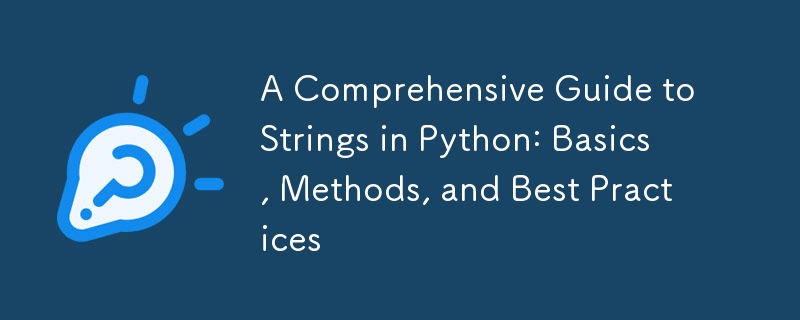Python 字串綜合指南:基礎知識、方法與最佳實踐
- Barbara Streisand原創
- 2024-10-09 20:13:281070瀏覽

字串是 Python 中最基本的資料類型之一,用於表示文字並有效地操作文字資料。理解字串對於任何 Python 開發人員來說都至關重要,無論您是初學者還是經驗豐富的程式設計師。在本文中,我們將探討 Python 中字串的各個方面,包括它們的建立、操作和內建方法。讓我們開始吧!
Python 中的字串是什麼?
在 Python 中,字串是用引號括起來的字元序列。您可以使用單引號 (')、雙引號 (") 或三引號(''' 或 """)建立字串。引號的選擇通常取決於個人喜好或需要在字串本身中包含引號。
字串建立範例
# Using single quotes single_quote_str = 'Hello, World!' # Using double quotes double_quote_str = "Hello, World!" # Using triple quotes for multi-line strings triple_quote_str = '''This is a multi-line string. It can span multiple lines.'''
字串連接
可以使用運算子組合或連接字串。這允許您從較小的字串創建更長的字串。
連接範例
str1 = "Hello" str2 = "World" result = str1 + " " + str2 print(result) # Output: Hello World
字串格式化
格式化字串對於建立動態內容至關重要。 Python 提供了多種格式化字串的方法,包括較新的 f-string(Python 3.6 及更高版本中提供)和 format() 方法。
字串格式範例
name = "Alice"
age = 30
# Using f-string
formatted_str = f"{name} is {age} years old."
print(formatted_str)
# Using format() method
formatted_str2 = "{} is {} years old.".format(name, age)
print(formatted_str2)
存取和切片字串
您可以使用索引存取字串中的各個字元。 Python 使用從零開始的索引,這意味著第一個字元的索引為 0。
訪問字元的範例
my_str = "Python" print(my_str[0]) # Output: P print(my_str[-1]) # Output: n (last character)
您也可以使用切片來提取子字串。
字串切片範例
my_str = "Hello, World!" substring = my_str[0:5] # Extracts 'Hello' print(substring) # Omitting start or end index substring2 = my_str[7:] # Extracts 'World!' print(substring2)
內建字串方法
Python提供了一組豐富的內建字串方法來輕鬆操作字串。一些常見的方法包括:
- strip():刪除前導和尾隨空格。
- upper():將字串轉換為大寫。
- lower():將字串轉換為小寫。
- replace(old, new):替換出現的子字串。
字串方法範例
my_str = " Hello, World! "
# Stripping whitespace
stripped_str = my_str.strip()
print(stripped_str)
# Converting to uppercase and lowercase
print(stripped_str.upper()) # Output: HELLO, WORLD!
print(stripped_str.lower()) # Output: hello, world!
# Replacing substrings
replaced_str = stripped_str.replace("World", "Python")
print(replaced_str) # Output: Hello, Python!
檢查子字串
您可以使用 in 關鍵字檢查字串中是否存在子字串。
子字串檢查範例
my_str = "Hello, World!"
print("World" in my_str) # Output: True
print("Python" in my_str) # Output: False
遍歷字串
您可以使用 for 迴圈遍歷字串中的每個字元。
遍歷字串的範例
for char in "Hello":
print(char)
連接字串
join() 方法可讓您將字串清單連接成單一字串。
連接字串的範例
words = ["Hello", "World", "from", "Python"] joined_str = " ".join(words) print(joined_str) # Output: Hello World from Python
逃脫角色
您可以使用反斜線 () 作為轉義字元在字串中包含特殊字元。
轉義字元範例
escaped_str = "She said, \"Hello!\"" print(escaped_str) # Output: She said, "Hello!"
結論
字串是 Python 中一種強大而靈活的資料類型,對於任何基於文字的應用程式都是必不可少的。透過掌握字串建立、操作和內建方法,您可以顯著提高您的程式設計技能並編寫更有效率的程式碼。無論您是格式化輸出、檢查子字串還是操作文字數據,理解字串都是成為熟練的 Python 開發人員的基礎。
以上是Python 字串綜合指南:基礎知識、方法與最佳實踐的詳細內容。更多資訊請關注PHP中文網其他相關文章!

